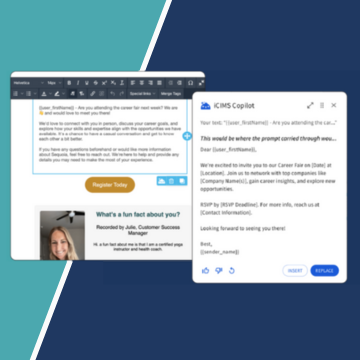- Solutions
- Products
- Community
- Resources
- Company
Create incredible candidate experiences that communicate your brand, mission, and values with recruitment marketing solutions.
Learn moreCommunicate effectively and efficiently with the candidates that can drive your business forward.
Learn moreSelect the right candidates to drive your business forward and simplify how you build winning, diverse teams.
Learn moreHelp your best internal talent connect to better opportunities and see new potential across your entire organization.
Learn moreCommunicate collectively with large groups of candidates and effectively tackle surges in hiring capacity.
Learn moreAccess tools that help your team create a more inclusive culture and propel your DEI program forward.
Learn moreRebound and respond to the new normal of retail with hiring systems that are agile enough to help you forge ahead.
Learn moreAccelerate the hiring of key talent to deliver point of care and support services that meet and exceed your promise of patient satisfaction.
Learn moreAttract and engage candidates with technical competencies, accelerate hiring for much-needed skills, and advance expertise within your valued workforce.
Learn moreSimplify how you recruit finance, insurance, and banking candidates with a unified platform built to match top talent with hard-to-fill roles.
Learn moreYour business strategy depends on your people strategy. Keep both in lockstep with the iCIMS Talent Cloud.
Learn moreBuild an engaging, high-converting talent pipeline that moves your business forward.
Learn moreDeliver the innovation your talent team needs, along with the global scale and security you demand.
Learn moreDeliver tailored technology experiences that delight users and power your talent transformation with the iCIMS Talent Cloud.
Learn moreThe #1 ATS in market share, our cloud-based recruiting software is built for both commercial and large, global employers.
Learn more Talk to salesAttract the best talent for your business with powerful, on-brand career websites that excite candidates and drive engagement.
Learn more Talk to salesCombine behavior-based marketing automation with AI insights to build talent pipelines, engage candidates with multi-channel marketing campaigns, and automatically surface the right talent for the job.
Learn more Talk to salesEmpower candidates with automated self-service, qualification screening, and interview scheduling through an AI-enabled digital assistant.
Learn more Talk to salesSimplify employee onboarding with automated processes that maximize engagement and accelerate productivity.
Learn more Talk to salesVerify skills with game-changing levels of automation and simplicity to improve the quality of hire at scale.
Learn more Talk to salesModernize, streamline, and accelerate your communication with candidates and employees.
Learn more Talk to salesTransform the talent experience by showcasing your authentic employer brand through employee-generated video testimonials.
Learn more Talk to salesSimplify recruiting, dynamically engage talent, and reduce hiring bias with job matching and recruiting chatbot technology.
Learn moreStreamline and centralize your HR tech stack with configurable, flexible, secure and reliable integrations.
Learn moreHow a beloved restaurant hires 40,000+ annually with a great candidate experience.
Learn moreThousands strong, our global community of talent professionals includes creatives, innovators, visionaries, and experts.
Learn moreTogether we’re creating the world’s largest ecosystem of integrated recruiting technologies.
Learn morePartner with our global professional services team to develop a winning strategy, build your team and manage change.
Learn moreExplore our network of more than 300 certified, trusted third-party service and advisory partners.
Learn moreUncover unique market insights, explore best practices and gain access to talent experts across out library of content.
Get resourcesExpert guidance about recruitment solutions, changes in the industry, and the future of talent.
Learn moreStay up to date with the latest terminology and verbiage in the HR software ecosystem.
Learn moreEmployers everywhere improve hiring efficiently and save money using iCIMS. Estimate the potential business value you can achieve.
Learn moreDive into the Class of 2023 Report highlighting this cohort’s expectations and where employers are willing — and able — to meet them.
Watch nowPartner with iCIMS to build the right strategies, processes, and experience to build a winning workforce.
Learn moreExpert guidance about recruitment solutions, changes in the industry, and the future of talent.
Learn moreDeliver the innovation your talent team needs, along with the global scale and security you demand.
Learn moreView press releases, media coverage, and the latest hiring data. See what analysts are saying about iCIMS.
Learn moreiCIMS is the Talent Cloud company that empowers organizations to attract, engage, hire, and advance the talent that builds a winning workforce.
Learn moreGet to know the award-winning leadership team shaping the future of the recruiting software industry.
Learn moreWe believe the future of work isn't something that "happens" to you. It's something you create. We actively create the future of work with our customers every day.
Learn moreiCIMS is committed to being a responsible and ethical corporate citizen, which is why Environmental, Social and Governance (ESG) initiatives are strategic imperatives.
Learn moreStreamline your tech stack and take advantage of a better user experience and stronger data governance with ADP and the iCIMS Talent Cloud.
Learn moreThe combined power of iCIMS and Infor helps organizations strategically align their business and talent objectives.
Learn moreOur award-winning partnership with Microsoft is grounded in a shared desire to transform the workplace and the hiring team experience.
Learn moreOur partnership with Ultimate Kronos Group (UKG) supports the entire talent lifecycle by bringing frictionless recruiting solutions to UKG Pro Onboarding.
Learn moreLet’s get in touch. Reach out to learn more about iCIMS products and services.
Learn more

Key Points
Recruiting is consumer-facing, making it more like sales and marketing than like other areas of HR. To give recruiting the focus it deserves, talent acquisition teams are building their strategies around a best-in-class applicant tracking system (ATS) rather than an HCM module.
Companies using best-of-breed for talent acquisition cited lower turnover than the industry average, a shorter time to fill positions, and an improved candidate experience, according to Aptitude Research Partners.
Many enterprise organizations build their tech stack with different best-in-class (e.g., best-of-breed) point solutions that work together seamlessly within one platform. The ability to manage and swap solutions without harming your data flow, workflow efficiency, and without going through prolonged procurement and implementation processes is key.
AmTrust Financial partnered with iCIMS to integrate a best-in-class ATS with its core HCM, Workday. Now the organization no longer relies on recruitment agencies to hit their hiring numbers. AmTrust saves $13 million in agency fees per year in the process.
A best-in-class ATS complements existing HCMs with seamless integration for optimal data flow – without daunting IT projects. The result is a strategic talent acquisition tech stack configured for your business’ unique needs, both now and in the future.


Configure your ATS and recruitment tech stack to meet your organization’s needs.
70% of job searches start on Google. Historically, that meant being routed through a third-party job board, where you’d be asked to create a profile. Then you’d get passed to the employer to fill out an application with the same personal information that you had just given to Indeed or Monster.
In less than three years, Google for Jobs has disrupted the industry and become the 3rd largest source of job seeker traffic for iCIMS’s ATS clients, an 81% increase from the beginning of the year. However, as ATS traffic skyrockets, job board traffic continues to take a nosedive.
Google continues to do what Google does best: collect real-time data from every source on the web to create an untouchable user experience. Google for Jobs doesn’t necessarily change candidates’ destination, but it does shorten their journey from initial keyword search to your ATS. The fewer middlemen, the more you save in advertising dollars.
This means that employers need to stay close to Google for Jobs with ATS capabilities that seamlessly send job listing data to the search giant, including salary ranges and precise location details. The result is a stronger candidate experience and a more cost-effective recruitment marketing strategy.
41% of employers rank AI and ML-powered solutions as their top priority, according to Mondo’s Creative and Digital Trends survey. Like self-driving cars, the buzz around the technology continues to build; however, the focus in recruiting is human-led AI.
AI, ML, and automation should exist in your applicant tracking system to:
Enter automated processes and conversational AI chatbots like those powered by ARI (Automated Recruiter Interface). ARI layers on top of your existing ATS and communicates with candidates when and where they prefer – such as text or Facebook Messenger.
The result is efficiency and reach. Your recruiters retain complete control without having to be plugged in 24/7. Your candidates have another way to interact with your brand how and when they choose.
Employers like the supermarket chain Dierbergs Markets use this to their advantage without breaking their existing tech stack. The team deployed conversational AI with ARI to engage with candidates in real-time. ARI gets smarter through each interaction with candidates and Dierbergs’ recruiting team has the flexibility to enable and disable ARI as needed.
For Dierbergs Markets and others, AI and ML represents hours recovered for their recruiters and for candidate engagement on a larger scale.
Want to learn more about tips and trends impacting your ATS strategy? Download and share our eBook, 20 Tips to Improve the Candidate Journey in 2020.




